Picture |
Satellite
#NORAD |
Description |
Launch Date |
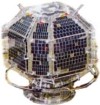
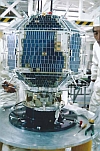
|
Fuji
OSCAR 29
FO-29
JAS-2
#24278
(1996-046B) |
Fuji Oscar 29 is a LEO
(low earth orbit) satellite with a size of 44cm width
and 47cm height. Its weight is 50 kg. The communication
systems include beacons, a digital store-and-forward
BBS message system, an analog communications transponder
and Digi-Talker.
The beacons are:
- 435.795
MHZ - CW beacon with 12 wpm and 100mW output
- 435.910
MHz - PSK digital or Digi-Talker
The analog transponder
(JA, 1 Watt) uses the following frequencies:
- 145.900-146.000
MHz uplink
- 435.800-435.900 MHz downlink (inverted)
The digital transponder (JD, 1 Watt) uses the following
frequencies:
- 145.850 MHz, 145.890 MHz, 145.910
MHz 1200bps AFSK uplinks
- 145.870 MHz 9600bps FSK
uplink
- 435.910 MHz 1200bps BPSK or 9600 bps FSK
downlink
- 435.910 MHz Digi-Talker FM Downlink |
Aug
17th 1996 |
 Synthesized
voice message of the Digi-Talker including the sound
of a cuckoo. Recorded on July 5th
1997 by Mike N1JEZ. Synthesized
voice message of the Digi-Talker including the sound
of a cuckoo. Recorded on July 5th
1997 by Mike N1JEZ.
|
 CW beacon
recorded March 5th 1999 14:15
UTC by DK3WN CW beacon
recorded March 5th 1999 14:15
UTC by DK3WN
|
 PSK beacon
recorded March 9th 1999 15:45
UTC by DK3WN PSK beacon
recorded March 9th 1999 15:45
UTC by DK3WN
|
 QSO DL1LSZ
and F1DPI in Mode JA on Sept. 3rd
2000 14:10 UTC, recorded by DK3WN QSO DL1LSZ
and F1DPI in Mode JA on Sept. 3rd
2000 14:10 UTC, recorded by DK3WN
|
 Synthesized
voice transmission of FO-29 in FM on 435.910 MHz Synthesized
voice transmission of FO-29 in FM on 435.910 MHz
|
 Another
synthesized voice message of FO-29 including the sound
of a bird. Recorded on June 10th
2000 by John KD2BD. Another
synthesized voice message of FO-29 including the sound
of a bird. Recorded on June 10th
2000 by John KD2BD.
|
 Synthesized
voice running twice as fast as it should be, recorded
by KD4APP on Aug 24rd 2003 Synthesized
voice running twice as fast as it should be, recorded
by KD4APP on Aug 24rd 2003
|
 After
a long period of deactivation in January 2010 the analog
transponder of FO-29 with a downlink transmit power
of 5W was switched back on. Excellent signals were reported
as demonstrated also in enclosed recording of a SSB
contact of SQ7DQX and PE0SAT. Recorded on January 29th
by Matt SQ7DQX. After
a long period of deactivation in January 2010 the analog
transponder of FO-29 with a downlink transmit power
of 5W was switched back on. Excellent signals were reported
as demonstrated also in enclosed recording of a SSB
contact of SQ7DQX and PE0SAT. Recorded on January 29th
by Matt SQ7DQX.
|
  On December 30th 2014
at 20:00 UTC Roland PY4ZBZ and Luciano PY5LF managed
to have a contact in CW via a cross-satellite link via
FO-29 and AO-7. PY5LF
transmitted on 432.150 MHz to AO-7 in CW mode. AO-7
retransmitted the CW signal on 145.950 MHz which was
received by FO-29. Finally FO-29 retransmitted the signal
on 435.850 MHz which was received by PY4ZBZ.Please
note that Doppler shift was minimum as the satellite
transponders are inversed and thus compensated nicely.Audio
recording and spectrogram screenshot kindly provided
by Roland PY4ZBZ. On December 30th 2014
at 20:00 UTC Roland PY4ZBZ and Luciano PY5LF managed
to have a contact in CW via a cross-satellite link via
FO-29 and AO-7. PY5LF
transmitted on 432.150 MHz to AO-7 in CW mode. AO-7
retransmitted the CW signal on 145.950 MHz which was
received by FO-29. Finally FO-29 retransmitted the signal
on 435.850 MHz which was received by PY4ZBZ.Please
note that Doppler shift was minimum as the satellite
transponders are inversed and thus compensated nicely.Audio
recording and spectrogram screenshot kindly provided
by Roland PY4ZBZ.
|
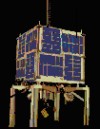
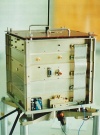
|
Mexico
OSCAR 30
MO-30
UNAMSAT-B
#24305
(1996-052B) |
Mexico OSCAR
30 was a LEO (low earth orbit) satellite and a secondary
payload launched with COSMOS 2334 (Parus #86).
MO-30 was built by the Autonomous University of Mexico
(UNAM). This Cubesat had the size of 15x15x15cm and
a weight of 10.7kg. The successful launch followed the
unsuccessful launch and destruction of UNAMSAT-A in
1995..
It featured a store-and-forward PACSAT protocol
suite communication system. The uplink was 1200 bps
AFSK on 145.815 MHz, 145.835 MHz, 145.855 MHz ad 145.875
MHZ. The 1200bps BPSK downlink with a transmit power
of 200-300mW was on 437.206 MHz (with a secondary downlink
on 435.138 MHz). UNAMSAT-B operated for 46 days sending
telemetry. Due to a flaw in the receiver the satellite
did not receive ground commands which were necessary
to stabilize the satellite's orbit.
 Enclosed
audio recording of MO-30 is from an unknown source. Enclosed
audio recording of MO-30 is from an unknown source.
|
Sep 5th
1996 |

|
RS 16
Mozhayets
Zeya
#24744
(1997-010A) |
 RS-16
was also called Mozhayets or Zeya. It carries 20 laser
reflectors for geodesy and Glonass and GPS receivers.
Its CW beacon was recorded on February 27th
1999 by DK3WN. RS-16
was also called Mozhayets or Zeya. It carries 20 laser
reflectors for geodesy and Glonass and GPS receivers.
Its CW beacon was recorded on February 27th
1999 by DK3WN.
|
Mar 4th
1997 |
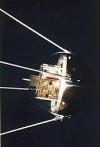
|
RS 17
Sputnik-40
Sputnik-Jr
#24958
(1997-058C) |
 In memoriam
to the first man made satellite Sputnik-1, which was
successfully launched 40 years before, this little satellite
was launched by hand during an EVA (Extra Vehicular
walking in space) from the MIR space station. The RF
signal sounded like a beep-beep as the transmitter with
a power of 100 to 200 mW was keyed on/off. The RF carrier
on 145.820 MHz In memoriam
to the first man made satellite Sputnik-1, which was
successfully launched 40 years before, this little satellite
was launched by hand during an EVA (Extra Vehicular
walking in space) from the MIR space station. The RF
signal sounded like a beep-beep as the transmitter with
a power of 100 to 200 mW was keyed on/off. The RF carrier
on 145.820 MHz was FM modulated and the frequency of the audio signal
varied with the temperature inside the satellite. Recorded
in FM on November 3rd 1997
12:45 UTC by IK1SLD. For confirming the reception by
a QSL card the award was given.
was FM modulated and the frequency of the audio signal
varied with the temperature inside the satellite. Recorded
in FM on November 3rd 1997
12:45 UTC by IK1SLD. For confirming the reception by
a QSL card the award was given.
|
Nov 3rd
1997 |
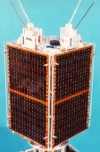
|
TMSat
OSCAR 31
TO-31
Thai-Micro-Sat
#25396
(1998-043C) |
I am searching
for sound files. Please send them to
 |
Jul 10th
1998 |
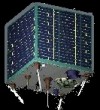
|
Gurwin
OSCAR 32
GO-32
TechSat1b
Gurwin II
#25397
(1998-043D) |
GO-32 was built by Technion
Institute of Technology in Israel and launched on a
Zenith-2 rocket from Baikonur Cosmodrome as one of 5
secondary payloads to the Resurs-O1-4 satellite. It
is of cubic shape with a size of 445 mm x 445 mm x 445
mm. The platform is three-axis stabilized, using a momentum
wheel and three magnetorquers as actuators, and a three-axis
magnetometer as attitude sensor.
It uses the callsigns
4XTECH-12 (for the BBS) and 4XTECH-11 for the beacon.
The following modes are supported:
Mode U TLM beacon
Downlink 435.3250 MHz
FSK 9600 BPS
Mode V/U (J) APRS (Set Path to be via
4XTECH)
Uplink: 145.9300
MHz FM 9600 BPS
Downlink
435.2250 MHz FM 9600 BPS
Mode V/U (J) PacSat BBS
Uplink: 145.8500 MHz FSK
9600 BPS
Uplink: 145.8500
MHz 1200BPS AFSK/APRS
Uplink:
145.8900 MHz FSK 9600 BPS
Uplink:
145.9300 MHz FSK 9600 BPS
Downlink
435.2250 MHz FSK 9600 BPS
Mode L/U PacSat BBS
Uplink: 1269.7000 MHz
FSK 9600 BPS
Uplink:
1269.8000 MHz FSK 9600 BPS
Uplink:
1269.9000 MHz FSK 9600 BPS
Downlink
435.2250 MHz FSK 9600 BPS |
Jul
10th 1998 |
 9600bd
FSK beacon recorded by Don Woodward, KD4APP, Aug 15th
2002 9600bd
FSK beacon recorded by Don Woodward, KD4APP, Aug 15th
2002
|
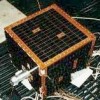
|
SedSat
OSCAR 33
SO-33
#25509
(1998-061B) |
 Single
burst of 9600bd FSK recorded by Don Woodward, KD4APP,
Nov 30th 2002 Single
burst of 9600bd FSK recorded by Don Woodward, KD4APP,
Nov 30th 2002
|
Oct 24th
1998 |
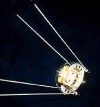
|
RS
18
Sputnik-41
#25533
(1998-062C) |
 Voice
messages in French, English, Russian recorded by DK3WN
on December 10th 1998 15:32
UTC Voice
messages in French, English, Russian recorded by DK3WN
on December 10th 1998 15:32
UTC
|
Nov
10th 1998 |
 Simple
telemetry downlink, audio frequency is a function of
temperature inside satellite, recorded by DK3WN Simple
telemetry downlink, audio frequency is a function of
temperature inside satellite, recorded by DK3WN
|
 Simple
beep-beep signal recorded by DK3WN Simple
beep-beep signal recorded by DK3WN
|
 Another
excellent recording of the Another
excellent recording of the  voice
messages was made by Harald DH8HHA in Munich on November
20th 1998. He received the
enclosed QSL card for sending in his reception report. voice
messages was made by Harald DH8HHA in Munich on November
20th 1998. He received the
enclosed QSL card for sending in his reception report.
|
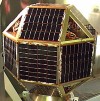
|
Pansat
OSCAR 34
PO-34
#25520
(1998-064B) |
PANSAT was
built by Naval Postgraduate School in Monterey and launched
from Shuttle mission STS-95 in a LEO.
I am
searching for sound files. Please send them to
 |
Oct 29th
1998 |
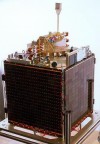
|
Sunsat
OSCAR 35
SO-35
#25636
(1999-008C) |
 FM-Repeater
recorded November 11th 1999
by DK3WN FM-Repeater
recorded November 11th 1999
by DK3WN
|
Feb
23rd 1999 |
 SunSat
in Parrot Mode recorded March 11th
2000 by DK3WN SunSat
in Parrot Mode recorded March 11th
2000 by DK3WN
|
 QSO DL1LSZ
and DG3DCH recorded August 16th
2000 18:50 UTC by DK3WN (ex DL1LSZ) QSO DL1LSZ
and DG3DCH recorded August 16th
2000 18:50 UTC by DK3WN (ex DL1LSZ)
|
 Rudolf
ZR6JRN (now ZS6FX) had a nice contact with ZS6HQ via
SO-35. Recording provided by Rudolf ZS6FX. Rudolf
ZR6JRN (now ZS6FX) had a nice contact with ZS6HQ via
SO-35. Recording provided by Rudolf ZS6FX.
|
 John K6YK
and Ted WA2HKS had a nice contact via SO-35. Recording
provided by John K6YK. John K6YK
and Ted WA2HKS had a nice contact via SO-35. Recording
provided by John K6YK.
|
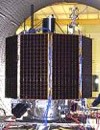
|
UoSAT
OSCAR 36
UO-36
UoSAT-12
#25693
(1999-021A) |
I am searching
for sound files. Please send them to
 |
Apr 21st
1999 |
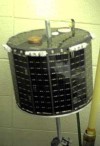
|
ASUSat
OSCAR 37
AO-37
ASUSat-1
#26065
(2000-004E) |
ASUSat-1 was a 6 kg-class
satellite designed, fabricated, tested, and tracked
by the students at Arizona State University.
I am searching for sound files. Please send them to
 |
Jan 27th
2000 |
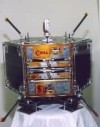
|
Opal OSCAR
38
OO-38
#26063
(2000-004C) |
 Opal
beacon transmission, complete pass on March 7th
2000 19:05-19:19 UTC recorded by DK3WN (please note
this file is 1.2 MByte large) Opal
beacon transmission, complete pass on March 7th
2000 19:05-19:19 UTC recorded by DK3WN (please note
this file is 1.2 MByte large)
|
Jan 27th
2000 |
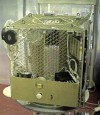
|
Weber
OSCAR 39
WO-39
JAWSat
#26061
(2000-004A) |
The Air Force Academy
and Weber State University have built the Joint Academy
Weber State Satellite (JAWSAT).
I am searching
for sound files. Please send them to
 |
Jan 27th
2000 |
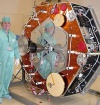
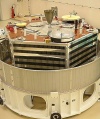

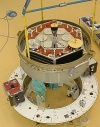


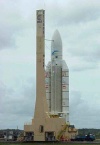
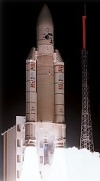
|
AMSAT
OSCAR 40
AO-40
Phase-3D
#26609
(2000-072B) |
AO-40 was launched on
November 16th 2000 on an Ariane
5 rocket (flight V135) from Kourou/French Guyana as
a secondary payload to PanAMSAT's PAS 1r. It was the
most sophisticated satellite built and launched by radio
amateurs at that time. The impressive transponder list
is given below:
Uplink Passbands
15m(A) 21.210-21.250
MHz
12m(A) 24.920-24.960
MHz
2m(V) 145.800-145.990
MHz
70cm(U) 435.300-435.800
MHz
23cm(L1) 1269.000-1269.500 MHz
23cm(L2) 1268.075-1268.575 MHz
13cm(S1) 2400.100-2400.600 MHz
13cm(S2)
2446.200-2446.700 MHz
6cm(C) 5668.300-5668.800
MHz
Downlink Passbands
2m(V) 145.805-145.990
MHz
70cm(U) 435.900-436.200
MHz / 435.475-435.725 MHz
13cm(S1) 2400.650-2400.950
MHz / 2400.225-2400.475 MHz
13cm(S2) 2401.650-2401.950
MHz / 2401.225-2401.475 MHz
3cm(X) 10451.450-10451.750
MHz / 10451.025-10451.275 MHz
1.5cm(K) 24048.025-24048.075
MHz
Beacon list: GB=General Beacon, MB=Middle
Beacon, EB=Engineering Beacon
2m(V) 145.898
MHz (MB)
70cm(U) 435.438
MHz (GB)
435.588
MHz (MB)
435.838
MHz (EB)
13cm(S1) 2400.188
MHz (GB)
2400.338
MHz (MB)
2400.588
MHz (EB)
13cm(S) 2401.173
MHz (GB)
2401.323
MHz (MB)
2401.573
MHz (EB)
3cm(X) 10450.975
MHz (GB)
10451.125
MHz (MB)
10451.375
MHz (EB)
1.5cm(K) 24047.885 MHz (GB)
24048.035
MHz (MB)
24048.285
MHz (EB) |
Nov
16th 2000 |
 The 2m
beacon signal was recorded by DK3WN on November 17th
2000 08:30 UTC when AO-40 was in a distance of 43000km. The 2m
beacon signal was recorded by DK3WN on November 17th
2000 08:30 UTC when AO-40 was in a distance of 43000km.
|
 The UHF-SHF
transponder of AO-40 had an excellent performance. Enclosed
contact of W7LRD and VE2DWE was recorded on August 26th
2002 by VE2DWE. He used for the 435 MHz UHF uplink 5W
and a 40 element crossed yagi and for the L-band downlink
a BBQ grill antenna with an AIDC 3733 2.4 GHz downconverter.
Recording kindly provided by VE2DWE. The UHF-SHF
transponder of AO-40 had an excellent performance. Enclosed
contact of W7LRD and VE2DWE was recorded on August 26th
2002 by VE2DWE. He used for the 435 MHz UHF uplink 5W
and a 40 element crossed yagi and for the L-band downlink
a BBQ grill antenna with an AIDC 3733 2.4 GHz downconverter.
Recording kindly provided by VE2DWE.
|
  Telemetry
beacon recorded by DJ1KM, member and strong contributor
to AMSAT-DL. Reinhard passed away in Oct 2006. Telemetry
beacon recorded by DJ1KM, member and strong contributor
to AMSAT-DL. Reinhard passed away in Oct 2006.
|
 QSO of
Don KD4APP and Stuart GW3XYW, recorded by Don on March
11th 2003. Kindly provided
by Don KD4APP. QSO of
Don KD4APP and Stuart GW3XYW, recorded by Don on March
11th 2003. Kindly provided
by Don KD4APP.
|
 QSO of
Frank DL6DBN and Andreas OE1DMB in German language.
Recorded and kindly provided by OE1DMB. QSO of
Frank DL6DBN and Andreas OE1DMB in German language.
Recorded and kindly provided by OE1DMB.
|
 AO40
transmitted its 400 bit/s beacon also on the 24 GHz
downlink. Note the spin fading due to the fact, that
both, the receive system and the 24 GHz transmitter,
used linearly polarized antennas. Received and kindly
provided by Michael OH2AUE. AO40
transmitted its 400 bit/s beacon also on the 24 GHz
downlink. Note the spin fading due to the fact, that
both, the receive system and the 24 GHz transmitter,
used linearly polarized antennas. Received and kindly
provided by Michael OH2AUE.
|
 In this
recording you can hear the CW signal of DK1KQ on the
24 GHz downlink while he was using the L-band uplink.
Received and kindly provided by Michael OH2AUE. In this
recording you can hear the CW signal of DK1KQ on the
24 GHz downlink while he was using the L-band uplink.
Received and kindly provided by Michael OH2AUE.
|
 Michael
also copied DB6NT in SSB on the 24 GHz downlink while
he was using the L-band uplink. Recorded and kindly
provided by Michael OH2AUE. Michael
also copied DB6NT in SSB on the 24 GHz downlink while
he was using the L-band uplink. Recorded and kindly
provided by Michael OH2AUE.
|
  On May
7th 2002 the U/K-band transponder
was used by Charles G3DWG and Mike N1JEZ for the first
transatlantic QSO with a joint 24GHz downlink. Please
note the rather low doppler shift due to the fact that
they used the transponder while AO40 was at apogee (distance
was about 61000 km). The output power of the K-band
transmitter was estimated to have dropped to about 600-800mW.
Recorded and kindly provided by Mike N1JEZ. On May
7th 2002 the U/K-band transponder
was used by Charles G3DWG and Mike N1JEZ for the first
transatlantic QSO with a joint 24GHz downlink. Please
note the rather low doppler shift due to the fact that
they used the transponder while AO40 was at apogee (distance
was about 61000 km). The output power of the K-band
transmitter was estimated to have dropped to about 600-800mW.
Recorded and kindly provided by Mike N1JEZ.
|
 On February
23rd 2003 the S1/K-band transponder
was tested. In enclosed recording of the 24 GHz downlink
you can hear Charles G3DWG and Domenico I8CVS + testing
the SSB transponder. Charles was transmitting on the
U-band uplink while Domenico was transmitting on the
S1-band uplink at 2401 MHz (10 Watt into a 1.2m dish).
Recording kindly provided by Mike N1JEZ. On February
23rd 2003 the S1/K-band transponder
was tested. In enclosed recording of the 24 GHz downlink
you can hear Charles G3DWG and Domenico I8CVS + testing
the SSB transponder. Charles was transmitting on the
U-band uplink while Domenico was transmitting on the
S1-band uplink at 2401 MHz (10 Watt into a 1.2m dish).
Recording kindly provided by Mike N1JEZ.
|
 This is
a contact between I8CVS +, IW1ERR and I5UXJ during orbit
867 and MA241 on September 20th
2002. Uplink was at 1268 MHz, downlink was at 2401 MHz
(Mode L/S). Recorded and audio file kindly provided
by Domenico I8CVS +. This is
a contact between I8CVS +, IW1ERR and I5UXJ during orbit
867 and MA241 on September 20th
2002. Uplink was at 1268 MHz, downlink was at 2401 MHz
(Mode L/S). Recorded and audio file kindly provided
by Domenico I8CVS +.
|
 This are
another 2 contacts on August 31st 2002
in LS-Mode. The first is between Jon ZS6JON and Frans
PA3CQE, the second is between Jon JS6JON and Rob PE1ITR.
The contacts were recorded by Frans PA3CQE. Audio file
kindly provided by Rob PE1ITR. This are
another 2 contacts on August 31st 2002
in LS-Mode. The first is between Jon ZS6JON and Frans
PA3CQE, the second is between Jon JS6JON and Rob PE1ITR.
The contacts were recorded by Frans PA3CQE. Audio file
kindly provided by Rob PE1ITR.
|
Her are some very special
goodies. They were not recorded while AO40 was in orbit
but during the various integration tests and the final
prelaunch tests in Kourou.
 The first
audio file is a test of the LEILA function in CW conducted
by OH2AUE during pre-launch tests. The first
audio file is a test of the LEILA function in CW conducted
by OH2AUE during pre-launch tests.
 The second
audio file is a test of the LEILA function in SSB conducted
also by OH2AUE in Kourou. The second
audio file is a test of the LEILA function in SSB conducted
also by OH2AUE in Kourou.
 The third
audio file was a test of the built in microphone of
AO40 by DB2OS (tapping the support frame). The third
audio file was a test of the built in microphone of
AO40 by DB2OS (tapping the support frame).
 The forth
audio file was another test of the micro. You can hear
Peter DB2OS "talking to the bird". The forth
audio file was another test of the micro. You can hear
Peter DB2OS "talking to the bird".
 The fifth
audio file was a test of the microphone already done
during one of the integration tests in Florida. All
three momentum wheels have achieved synch to the programmed
test values. Analyzing the audio spectrum with a PC
FFT program you can see the frequencies and thus calculate
the rotation speed of the wheels directly. The fifth
audio file was a test of the microphone already done
during one of the integration tests in Florida. All
three momentum wheels have achieved synch to the programmed
test values. Analyzing the audio spectrum with a PC
FFT program you can see the frequencies and thus calculate
the rotation speed of the wheels directly.
 The sixth
audio file is the 400bd PSK beacon recorded during thermal
vacuum tests in Virginia. The sixth
audio file is the 400bd PSK beacon recorded during thermal
vacuum tests in Virginia.
  The seventh
audio file is also the 400bd PSK beacon received on
70cm band during tests on June 26th
1999. If you decode this file with the AO40RCV freeware
then you can decode 4 blocks of data which I enclose
also a s a text file. The seventh
audio file is also the 400bd PSK beacon received on
70cm band during tests on June 26th
1999. If you decode this file with the AO40RCV freeware
then you can decode 4 blocks of data which I enclose
also a s a text file.
 This
is the last special from AO-40. You can decode this
audio file with the P3T software. The result is great
fun as you can see from the telemetry that all RF transmitters
are turned OFF, only the IR laser is turned ON. This
was probably the only time that the IR laser was ever
actually received and demodulated + decoded. The laser
was never tested in space. Michael OH2AUE made this
recording during the launch preparation and final tests
in Kourou. This
is the last special from AO-40. You can decode this
audio file with the P3T software. The result is great
fun as you can see from the telemetry that all RF transmitters
are turned OFF, only the IR laser is turned ON. This
was probably the only time that the IR laser was ever
actually received and demodulated + decoded. The laser
was never tested in space. Michael OH2AUE made this
recording during the launch preparation and final tests
in Kourou.
All these recordings were kindly
provided by Michael Fletcher OH2AUE. |
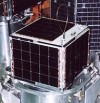
|
Saudi
OSCAR 41
SO-41
SaudiSat-1A
#26546
(2000-057B) |
 QSOs
of DK3WN and HB9SKA, recorded by DK3WN on April 13th
2002 12:35 UTC. QSOs
of DK3WN and HB9SKA, recorded by DK3WN on April 13th
2002 12:35 UTC.
|
Sep26th
2000 |
 QSOs
of KD4APP and WA1ECF, recorded by Don on June 16th
2002 QSOs
of KD4APP and WA1ECF, recorded by Don on June 16th
2002
|

|
Saudi OSCAR
42
SO-42
SaudiSat-1B
#26549
(2000-057E) |
I am searching
for sound files. Please send them to
 |
Sep26th
2000 |
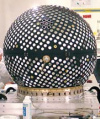
|
Starshine
OSCAR 43
SO-43
Starshine-3
#26929
(2001-043A) |
Starshine
transmitted 9600bd ASCII data like:
STRSHN>AP5152:>de
N7YTK.040029DB000029C3
A438813D026BFC6D534F84829A327868932A0273F
C8B65DF70462A5C6EED9D22027BFC2246914EB6
A4AE650182780289FC98D29482F30206619C84F30
271FC1A6D4B285F9BD964E700C20281
SO-43 decayed on
January 21st 2003.
I am searching for sound files. Please
send them to
 |
Sep30th
2001 |
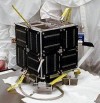
|
Nav
OSCAR 44
NO-44
PCSat
#26931
(2001-043C) |
 PCSat
1200Bd AFSK packet frame on 145.825 MHz recorded by
DK3WN on October 20th 2001 PCSat
1200Bd AFSK packet frame on 145.825 MHz recorded by
DK3WN on October 20th 2001
|
Sep30th
2001 |
  Here
you can find an audio-file as well as a log-file of
the transmissions of NO-44 on January 7th 2007 which
I relayed to the internet. Recorded by DD1US on January
7th 2007 by DD1US. Here
you can find an audio-file as well as a log-file of
the transmissions of NO-44 on January 7th 2007 which
I relayed to the internet. Recorded by DD1US on January
7th 2007 by DD1US.
|
 On May
6th 2015 at 15:35 UTC Francisco
EA7ADI received the CW signal of NavOSCAR 44. Recording
kindly provided by Francisco EA7ADI. On May
6th 2015 at 15:35 UTC Francisco
EA7ADI received the CW signal of NavOSCAR 44. Recording
kindly provided by Francisco EA7ADI.
|
 On December
12th 2001 PCSat transmitted
"S" and "HI" every 3 minutes. This
to commemorate the 40th anniversary
of the first Amateur Radio Satellite OSCAR-1 launched
on December 12th 1961 and also
to celebrate the 100th anniversary
of Guglielmo Marconi's historic transatlantic transmission
of the letter "S" in 1901. Received and recording
kindly provided by Alex KR1ST. On December
12th 2001 PCSat transmitted
"S" and "HI" every 3 minutes. This
to commemorate the 40th anniversary
of the first Amateur Radio Satellite OSCAR-1 launched
on December 12th 1961 and also
to celebrate the 100th anniversary
of Guglielmo Marconi's historic transatlantic transmission
of the letter "S" in 1901. Received and recording
kindly provided by Alex KR1ST.
|
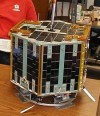
|
Nav
OSCAR 45
NO-45
Sapphire
#26932
(2001-043D) |
 Synthesized
Voice Messages: "Happy Birthday OSCAR-1" and
"Thank you Mr. Marconi", received by HB9SKA Synthesized
Voice Messages: "Happy Birthday OSCAR-1" and
"Thank you Mr. Marconi", received by HB9SKA
|
Sep30th
2001 |
 CW beacon
signal received by DK3WN on October 19th
2001 13:45 UTC. CW beacon
signal received by DK3WN on October 19th
2001 13:45 UTC.
|
 Un-modulated
keying of NO-45 every 20 seconds, recorded by KD4APP
on Dec 20th 2002, 15:00 UTC Un-modulated
keying of NO-45 every 20 seconds, recorded by KD4APP
on Dec 20th 2002, 15:00 UTC
|
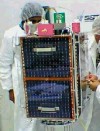
|
MySat OSCAR
46
MO-46
TiungSAT-1
MalaysianSat-1
#26548
(2000-057D) |
I am searching
for sound files. Please send them to
 |
Sep26th
2000 |
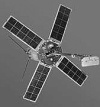
|
RS 21
Kolibri-2000
#27394
(2001-051C) |
 The Russian-Australian
scientific-educational Kolibri-2000 micro-satellite
was launched into space from the International Space
Station. CW beacon signal of on 70cm (435.335 MHz) on
April 20th 2002 recorded by
DK3WN The Russian-Australian
scientific-educational Kolibri-2000 micro-satellite
was launched into space from the International Space
Station. CW beacon signal of on 70cm (435.335 MHz) on
April 20th 2002 recorded by
DK3WN
|
Mar 19th
2002 |
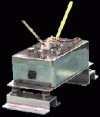
|
Breizh
OSCAR 47
BO-47
Idefix CU-1
#27422
(2002-021B) |
 PSK signal
of the 2m downlink of Idefix recorded by DK3WN PSK signal
of the 2m downlink of Idefix recorded by DK3WN
|
May
4th 2002 |
 Synthesized
message in German language recorded by DK3WN Synthesized
message in German language recorded by DK3WN
|
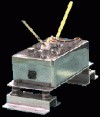
|
Breizh
OSCAR 48
BO-48
Idefix CU-2
#27422
(2002-021B) |
 CW beacon
signal on 70cm downlink CW beacon
signal on 70cm downlink  recorded
by DK3WN. Here is a picture of the rusty key of F6AGR,
which was used for generating the CW signals and storing
them in the memory of the satellite. recorded
by DK3WN. Here is a picture of the rusty key of F6AGR,
which was used for generating the CW signals and storing
them in the memory of the satellite.
|
May
4th 2002 |
 Synthesized
message in German language on 70cm downlink recorded
by DK3WN Synthesized
message in German language on 70cm downlink recorded
by DK3WN
|
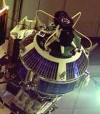
|
RS
20
Mozhayets
#27560
(2002-054B) |
RS-20 was another Russian
amateur radio satellite based on the Strela 1M platform.
It featured 2 downlinks, on 145.828 MHz in FM or CW
and on 435.319 MHz in FM or CW. |
Nov
28th 2002 |
 FM signal
with data transmission on 70cm downlink (435.317 MHz)
recorded by DK3WN on Dec 3rd
2002 20:15 UTC. FM signal
with data transmission on 70cm downlink (435.317 MHz)
recorded by DK3WN on Dec 3rd
2002 20:15 UTC.
|
 CW beacon
signal received in USB on 70cm downlink (435.312 MHz)
recorded by DK3WN on Dec 3rd
2002 21:52 UTC (audio file was compressed) CW beacon
signal received in USB on 70cm downlink (435.312 MHz)
recorded by DK3WN on Dec 3rd
2002 21:52 UTC (audio file was compressed)
|
 CW beacon
signal of 70cm downlink recorded by Don Woodward, KD4APP,
Dec 8th 2002 CW beacon
signal of 70cm downlink recorded by Don Woodward, KD4APP,
Dec 8th 2002
|

|
AATiS OSCAR
49
AO-49
Safir-M
RUBIN-2
#27605
(2002-058A) |
 This
satellite was built by the University of Pforzheim /
Germany and supported by AATiS (Arbeitskreis Amateurfunk
und Telekommunikation in der Schule). SAFIR-M was a
payload of RUBIN-2, an experimental micro-satellite
operated by OHB in Bremen/Germany. The 2m downlink of
AO-49 is a 9600bd MSK signal and sounds like noise.
AO-49 used the callsign DP0AIS. Recorded by Michael
DG1CMZ. This
satellite was built by the University of Pforzheim /
Germany and supported by AATiS (Arbeitskreis Amateurfunk
und Telekommunikation in der Schule). SAFIR-M was a
payload of RUBIN-2, an experimental micro-satellite
operated by OHB in Bremen/Germany. The 2m downlink of
AO-49 is a 9600bd MSK signal and sounds like noise.
AO-49 used the callsign DP0AIS. Recorded by Michael
DG1CMZ.
|
Dec 20th
2002 |

|
Saudi
OSCAR 50
SO-50
SaudiSat-1C
#27607
(2002-058C) |
Saudi OSCAR 50 was built
by King Abdulaziz University for Science & Technology.
SO-50 features a Mode V/U (J) FM Voice Repeater. The
uplink frequency of this bent pipe FM repeater is 145.8500
MHz (FM, PL 67.0 Hz), the downlink frequency is 436.7950
MHz (FM). To switch the transmitter on a 2 seconds carrier
with a 74.4 Hz CTCSS tone has to be sent. This satellite
can be worked with simple FM equipment. |
Dec
20th 2002 |
 KD4APP
calling CQ via SO-50, recorded by Don KD4APP on Jan
3rd 2003, 7:56 UTC KD4APP
calling CQ via SO-50, recorded by Don KD4APP on Jan
3rd 2003, 7:56 UTC
|
 QSO of
G4FUN and SM/IW4BLG during AMSAT Colloquium at University
of Surrey, recorded by DK3WN on July 30th
2004 14:10 UTC. QSO of
G4FUN and SM/IW4BLG during AMSAT Colloquium at University
of Surrey, recorded by DK3WN on July 30th
2004 14:10 UTC.
|
 QSO of
N6LY and KF6KYI both operating with handheld transceivers
recorded by KF6KYI on March 5th
2008. QSO of
N6LY and KF6KYI both operating with handheld transceivers
recorded by KF6KYI on March 5th
2008.
|
 The station
DC2HC operating via SO-50 was briefly received and recorded
on March 14th 2010 at 16:47
UTC on 436.799 MHz by DD1US. The station
DC2HC operating via SO-50 was briefly received and recorded
on March 14th 2010 at 16:47
UTC on 436.799 MHz by DD1US.
|
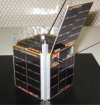
|
Cubesat
OSCAR 55
CO-55
Cute-1
#27844
(2003-031E) |
This satellite was launched
together with 5 other Cubesats by a ROCKOT launch vehicle
from the Plesetsk Cosmodrome in Northern Russia. It
was built by Tokyo Institute of Technology and includes
a CW beacon (downlink 436.8375 MHz) as well as a 2nd
downlink for PR on 437.470 MHz (1200 bps FM AFSK, AX.25.
Its callsign is JQ1YCY. |
Jun
30th 2003 |
 Rob Hardenberg
received the signal from Cute-1 on June 30th
2003 at 19:10 UTC only a few hours after its launch.
Audio recording kindly provided by Rob PE1ITR. Rob Hardenberg
received the signal from Cute-1 on June 30th
2003 at 19:10 UTC only a few hours after its launch.
Audio recording kindly provided by Rob PE1ITR.
|
 Another
recording of the CW transmission of Cute-1 from July
2nd 2003 at 07:10 UTC was kindly
provided by Rob PE1ITR. Another
recording of the CW transmission of Cute-1 from July
2nd 2003 at 07:10 UTC was kindly
provided by Rob PE1ITR.
|
 CW downlink
recorded by DK3WN on May 9th
2005 17:50 UTC. Audio recording kindly provided by Mike
DK3WN. CW downlink
recorded by DK3WN on May 9th
2005 17:50 UTC. Audio recording kindly provided by Mike
DK3WN.
|
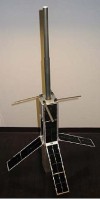
|
QuakeSat
#27845
(2003-031F) |
The 3-kilogram QuakeSat,
which was being built by Stanford University students
as part of its CubeSat program, covered Earth every
four days in a near polar orbit 700-900 kilometers
in altitude. It features a single axis magnetometer
and a small E-field dipole antenna. The objective is
the detection of ELF signatures. QuakeSat transmits
on 436.675 MHz in FM FSK 9600bd AX.25 telemetry. It
uses the callsign KD7OVB. |
Jun
30th 2003 |
 Rob Hardenberg
received the signal from QuakeSat on July 2th
2003 at 07:05 UTC on 436.675 MHz . Audio recording kindly
provided by Rob PE1ITR. Rob Hardenberg
received the signal from QuakeSat on July 2th
2003 at 07:05 UTC on 436.675 MHz . Audio recording kindly
provided by Rob PE1ITR.
|
 Rob Hardenberg
received the signal from QuakeSat also on its next pass
on July 2th 2003 at 08:38 UTC
on 436.675 MHz. Audio recording kindly provided by Rob
PE1ITR. Rob Hardenberg
received the signal from QuakeSat also on its next pass
on July 2th 2003 at 08:38 UTC
on 436.675 MHz. Audio recording kindly provided by Rob
PE1ITR.
|
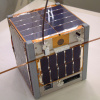
|
Cubesat
OSCAR 57
CO-57
XI-IV
#27848
(2003-031J) |
This satellite was launched
together with 5 other Cubesats by a ROCKOT launch vehicle
from the Plesetsk Cosmodrome in Northern Russia. It
was built by Tokyo Institute of Technology and includes
a CW beacon (downlink 436.8475 MHz) as well as a 2nd
downlink for PR on 437.490 MHz (1200 bps FM AFSK, AX.25.
Its callsign is JQ1YCW. |
Jun
30th 2003 |
 Rob Hardenberg
received the CW beacon signal from Cubesat OSCAR 57
on July 2th 2003 at 08:38 UTC
on 436.8475 MHz. Audio recording kindly provided by
Rob PE1ITR. Rob Hardenberg
received the CW beacon signal from Cubesat OSCAR 57
on July 2th 2003 at 08:38 UTC
on 436.8475 MHz. Audio recording kindly provided by
Rob PE1ITR.
|
 CW telemetry
recorded by DK3WN on July 5th
2003 06:00 UTC. Audio recording kindly provided by Mike
DK3WN. CW telemetry
recorded by DK3WN on July 5th
2003 06:00 UTC. Audio recording kindly provided by Mike
DK3WN.
|
 The CW
beacon signal from CO-57 was received on March 19th
2015 at 17:52 UTC by Francisco EA7ADI. Recording kindly
provided by Francisco EA7ADI. The CW
beacon signal from CO-57 was received on March 19th
2015 at 17:52 UTC by Francisco EA7ADI. Recording kindly
provided by Francisco EA7ADI.
|
 The CW
beacon signal from CO-57 was also received on May 7th
2015 at 17:40 UTC by Francisco EA7ADI. Recording kindly
provided by Francisco EA7ADI. The CW
beacon signal from CO-57 was also received on May 7th
2015 at 17:40 UTC by Francisco EA7ADI. Recording kindly
provided by Francisco EA7ADI.
|
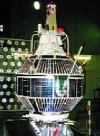
|
RS
22
Mozhayets-4
#27939
(2003-042A) |
RS-22 was another Russian
amateur radio satellite based on the Strela 1M platform
built by the Mozhaisky military academy. It was launched
from Baykonur on a Dnepr rocket into a retrograde polar
orbit with an inclination of 98.43 degrees. The perigee
was 657 km and the apogee was 693 km. |
Sep
27th 2003 |
 CW beacon
signal on 435.352 MHz recorded by DK3WN on July 14th
2004 22:00 UTC. CW beacon
signal on 435.352 MHz recorded by DK3WN on July 14th
2004 22:00 UTC.
|
 FM signal
with data transmission recorded by DK3WN while RS-22
being in the range of the ground control station FM signal
with data transmission recorded by DK3WN while RS-22
being in the range of the ground control station
|
 CW beacon
signal of 70cm downlink recorded by Don Woodward, KD4APP,
Aug 9th 2004 CW beacon
signal of 70cm downlink recorded by Don Woodward, KD4APP,
Aug 9th 2004
|
 CW telemetry
signal recorded by Mark KF6KYI on April 25th
2008. CW telemetry
signal recorded by Mark KF6KYI on April 25th
2008.
|
 The CW
beacon signal from RS-22 was received on April 15th
2015 at 15:21 UTC by Francisco EA7ADI. Recording kindly
provided by Francisco EA7ADI. The CW
beacon signal from RS-22 was received on April 15th
2015 at 15:21 UTC by Francisco EA7ADI. Recording kindly
provided by Francisco EA7ADI.
|
 The CW
beacon signal from RS-22 was received again on April
23rd 2015 at 17:04 UTC by Francisco
EA7ADI. Recording kindly provided by Francisco EA7ADI. The CW
beacon signal from RS-22 was received again on April
23rd 2015 at 17:04 UTC by Francisco
EA7ADI. Recording kindly provided by Francisco EA7ADI.
|
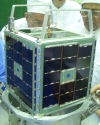

|
AMSAT
OSCAR 51
AO-51
OSCAR-E
Echo
#28375
(2004-025K) |
 Transponder
in test mode (FM repeater mode with uplink at 145.92
MHz and downlink at 435.300 MHz)), multiple stations
were recorded on July 30th
2004 11:00UTC by Mike DK3WN Transponder
in test mode (FM repeater mode with uplink at 145.92
MHz and downlink at 435.300 MHz)), multiple stations
were recorded on July 30th
2004 11:00UTC by Mike DK3WN
|
Sep
26th 2004 |
 Perfect
QSO of PA3GUO and F6CDZ on March 31st
2005, recorded by Henk PA3GUO Perfect
QSO of PA3GUO and F6CDZ on March 31st
2005, recorded by Henk PA3GUO
|
 ON5NY
calling CQ on the 13cm FM downlink at 2401.200 MHz while
AO-51 was in experimental mode. Recorded on September
3rd 2006 by Vladimir RA3DQT ON5NY
calling CQ on the 13cm FM downlink at 2401.200 MHz while
AO-51 was in experimental mode. Recorded on September
3rd 2006 by Vladimir RA3DQT
|
 The transponder
of AO-51 could also be used for digital transmissions.
The enclosed PSK31 signal was recorded on 435.300 MHz
by Maik Hermenau. The transponder
of AO-51 could also be used for digital transmissions.
The enclosed PSK31 signal was recorded on 435.300 MHz
by Maik Hermenau.
|
 In January
2008 AO-51 was operational with the 2m FM uplink and
the 13cm FM downlink activated. In the audio file enclosed
you can hear why such a mode requires highly disciplined
operators, which is unfortunately not always the case.
Recorded on 2.4 GHz in FM on January 29th
2008 by Gerd DL8DR. In January
2008 AO-51 was operational with the 2m FM uplink and
the 13cm FM downlink activated. In the audio file enclosed
you can hear why such a mode requires highly disciplined
operators, which is unfortunately not always the case.
Recorded on 2.4 GHz in FM on January 29th
2008 by Gerd DL8DR.
|
 The FM
downlink signal was recorded by Mark KF6KYI on February
10th 2008. The FM
downlink signal was recorded by Mark KF6KYI on February
10th 2008.
|
The SSTV pictures below from KB2HSH,
KC9MLN and VE2DWE were received via AO-51 on Nov 14th
2008 at 23:30UTC by Al W8KHP.     |
 End of
December 2009 Matt SQ7DQX had 2 nice contacts with UA9UIZ
and OZ1MY. The uplink mode was SSB, the downlink mode
FM. Recorded on December 30th
2009 at 13:43UTC by SQ7DQX. End of
December 2009 Matt SQ7DQX had 2 nice contacts with UA9UIZ
and OZ1MY. The uplink mode was SSB, the downlink mode
FM. Recorded on December 30th
2009 at 13:43UTC by SQ7DQX.
|
 On April
3rd 2010 Alex VK5ALX and Murray
ZL3MH had an excellent voice contact lasting 7 minutes
and using the S-band narrowband FM downlink. The downlink
frequency was 2401.2 MHz +/- doppler. Alex VK5ALX lives
in Whyalla, South Australia and used a recycled MMDS
pay TV down converter and ICOM IC-910H transceiver.
Recorded by VK5ALX on April 3rd
2010 starting 08:07 UTC. On April
3rd 2010 Alex VK5ALX and Murray
ZL3MH had an excellent voice contact lasting 7 minutes
and using the S-band narrowband FM downlink. The downlink
frequency was 2401.2 MHz +/- doppler. Alex VK5ALX lives
in Whyalla, South Australia and used a recycled MMDS
pay TV down converter and ICOM IC-910H transceiver.
Recorded by VK5ALX on April 3rd
2010 starting 08:07 UTC.
|
 On February
17th 2009 Patrick DK193WN received
the FM downlink on 435.500MHz. Recording kindly provided
by Patrick Hajagos DK193WN. On February
17th 2009 Patrick DK193WN received
the FM downlink on 435.500MHz. Recording kindly provided
by Patrick Hajagos DK193WN.
|
  On
July 20th 2009 AMSAT-NA marked
the 40th anniversary of the
first manned lunar landing of Apollo 11 with a special
event. AO-51 was transmitting original voice messages
as well as an SSTV picture in Robot 36 mode of the landing. On
July 20th 2009 AMSAT-NA marked
the 40th anniversary of the
first manned lunar landing of Apollo 11 with a special
event. AO-51 was transmitting original voice messages
as well as an SSTV picture in Robot 36 mode of the landing.
Received and recorded on July 20th
2009 at 17:29 UTC on 435.300 MHz in FM mode by M0UKD.
Kindly contributed by John M0UKD.
|
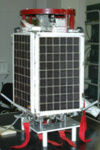
|
RS-23
Universitetsky
Tatiana
#28523
(2005-002C) |
 This
satellite with a weight of 30 kg was launched on Kosmso-3M
rocket to mark the 250th anniversary of Moscow State
University (MGU). It transmits 2400 Baud digital data
on 435.215 MHz in NFM. Recorded on September 27th
2005 at 09:50 UTC by Maik Hermenau. This
satellite with a weight of 30 kg was launched on Kosmso-3M
rocket to mark the 250th anniversary of Moscow State
University (MGU). It transmits 2400 Baud digital data
on 435.215 MHz in NFM. Recorded on September 27th
2005 at 09:50 UTC by Maik Hermenau.
|
Jan 20th
2005 |
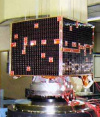
|
VUsat
OSCAR 52
VO-52
VUsat-52
HAMSAT
#28650
(2005-017B) |
 Indian
satellite, 42kg, carries 2 UHF/VHF linear transponders
(an Indian and a Dutch), un-modulated Indian beacon
recorded May 7th 2005 10:13
UTC by DD1US Indian
satellite, 42kg, carries 2 UHF/VHF linear transponders
(an Indian and a Dutch), un-modulated Indian beacon
recorded May 7th 2005 10:13
UTC by DD1US
|
May
5th 2005 |
 Indian
linear transponder with uplink between 435.225 and 435.275
MHz (LSB) and downlink from 145.875 to 145.925 MHz (USB).
QSO of Pali HA8ARP and Henk PA3GUO recorded May 7th
2005 10:10 UTC by Matthias DD1US Indian
linear transponder with uplink between 435.225 and 435.275
MHz (LSB) and downlink from 145.875 to 145.925 MHz (USB).
QSO of Pali HA8ARP and Henk PA3GUO recorded May 7th
2005 10:10 UTC by Matthias DD1US
|
 The Dutch
transponder was activated first time on Nov 17th
2005. The transponder was built by William PE1RAH. This
is a QSO between William (JO31RH) and OZ1MY (JO65FR)
during this first day of operation recorded at 19:17
UTC on a downlink frequency of 145.906 MHz by Matthias
DD1US The Dutch
transponder was activated first time on Nov 17th
2005. The transponder was built by William PE1RAH. This
is a QSO between William (JO31RH) and OZ1MY (JO65FR)
during this first day of operation recorded at 19:17
UTC on a downlink frequency of 145.906 MHz by Matthias
DD1US
|
 The CW
beacon of the Durch transponder. transmits on 145.860
MHz +/- doppler. Recorded on Nov 18th
2005 at 19:38 UTC by Matthias DD1US The CW
beacon of the Durch transponder. transmits on 145.860
MHz +/- doppler. Recorded on Nov 18th
2005 at 19:38 UTC by Matthias DD1US
|
 The SSB
transponder downlink signal with several stations was
recorded by Mark KF6KYI on January 29th
2008. The SSB
transponder downlink signal with several stations was
recorded by Mark KF6KYI on January 29th
2008.
|
 On February
8th 2009 at 03:00 UTC Drew
KO4MA received the enclosed interferer on the downlink
of VO-52 (on 145.910 MHz in FM). It seems to be a broadcast
signal with spanish language. Whoever can help to identify
the source should send me an Email. On February
8th 2009 at 03:00 UTC Drew
KO4MA received the enclosed interferer on the downlink
of VO-52 (on 145.910 MHz in FM). It seems to be a broadcast
signal with spanish language. Whoever can help to identify
the source should send me an Email.
|
 On November
28th 2011 Domenico I8CVS +
had a contact using the Indian Mode-B transponder of
VO-52 with IW6OVD. Recording kindly provided by Domenico
I8CVS +. On November
28th 2011 Domenico I8CVS +
had a contact using the Indian Mode-B transponder of
VO-52 with IW6OVD. Recording kindly provided by Domenico
I8CVS +.
|
 On March
27th 2012 Domenico I8CVS +
had a contact using the Dutch Mode-B transponder of
VO-52 with IW6OVD. Recording kindly provided by Domenico
I8CVS +. On March
27th 2012 Domenico I8CVS +
had a contact using the Dutch Mode-B transponder of
VO-52 with IW6OVD. Recording kindly provided by Domenico
I8CVS +.
|
 In enclosed
recording you can hear PE0SAT calling CQ via VO-52 and
making nice contacts with G54CFS, YT3N, IK8YSS. Recorded
on March 20th 2013 at 19:33
UTC. Recording kindly provided by Jan PE0SAT. In enclosed
recording you can hear PE0SAT calling CQ via VO-52 and
making nice contacts with G54CFS, YT3N, IK8YSS. Recorded
on March 20th 2013 at 19:33
UTC. Recording kindly provided by Jan PE0SAT.
|
 The CW-beacon
of VO-52 was received on March 15th 2014 at 17:21 UTC
by DD1US. The CW-beacon
of VO-52 was received on March 15th 2014 at 17:21 UTC
by DD1US.
|
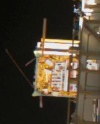
|
NAV
OSCAR
PCSat 2
#25544
(1998-067A) |
 This
payload was brought to ISS by Space Shuttle Discovery
on July 26th and assembled outside of the international
space station on August 3rd 2005. It includes a PSK31-
multi-user transponder (435.275 MHz), an FM voice repeater
which can also used by the astronauts on ISS (435.275
MHz) as well as a packet radio system (435.275 MHz).
Its beacons can be received on 437.975 MHz. This recording
of the 1k2 and 9k6 telemetry beacon was done by Mike
DK3WN on Nov. 12th 2005 at
17:36 UTC. This
payload was brought to ISS by Space Shuttle Discovery
on July 26th and assembled outside of the international
space station on August 3rd 2005. It includes a PSK31-
multi-user transponder (435.275 MHz), an FM voice repeater
which can also used by the astronauts on ISS (435.275
MHz) as well as a packet radio system (435.275 MHz).
Its beacons can be received on 437.975 MHz. This recording
of the 1k2 and 9k6 telemetry beacon was done by Mike
DK3WN on Nov. 12th 2005 at
17:36 UTC.
|
July
26th 2005 |
 During
its final days in space PCSat2 was in a special event
mode, which included a voice downlink for control stations. During
its final days in space PCSat2 was in a special event
mode, which included a voice downlink for control stations.
 They
reported in voice the APRS stations heard over PCSAT2. They
reported in voice the APRS stations heard over PCSAT2.
 In that
mode Henk PA3GUO operated PCSat2 and also chatted with
Mike DK3WN who was also control station for PCSat2 at
that time. In that
mode Henk PA3GUO operated PCSat2 and also chatted with
Mike DK3WN who was also control station for PCSat2 at
that time.
All 3 files were recorded on Aug 31st
2006 by Henk PA3GUO.
|
PCSat was finally retrieved
during an EVA on Sept 15th
2006 and brought back to Earth. |
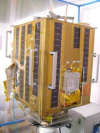
|
EXpress-OSCAR
53
EO-53
SSETI-EXpress
#28894
(2005-043E) |
This first pan-European
student micro-satellite was built by a distributed team
of university students and radio amateurs throughout
Europe. It was sponsored by ESA and launched together
with 5 Cubesats on a russian rocket KOSMOS-3M (ROCKOT)
from the Plesetsk Cosmodrome in Northern Russia. The
amateur radio payload had downlinks on 437.250 MHz (FSK,
9k6 AX.25) as well as 2401.835 MHz (FSK, 38k4 AX.25,
3 Watt). |
Oct
27th 2005 |
  Unfortunately
the satellite was operational only for 5 orbits and
then shut down due to a lack of power. The 9600bd packets
transmitted every 18 seconds were recorded on October
27th 2007 at 09:13 UTC on 437.250
MHz in FM by Ian Ashley ZL1AOX. Besides you can also
read the decoded data of this transmission. Unfortunately
the satellite was operational only for 5 orbits and
then shut down due to a lack of power. The 9600bd packets
transmitted every 18 seconds were recorded on October
27th 2007 at 09:13 UTC on 437.250
MHz in FM by Ian Ashley ZL1AOX. Besides you can also
read the decoded data of this transmission.
|
 This
is a recording of the "safe mode" pulse beacon.
This came on when the battery volts fell too low for
the main system to operate and was heard by a number
of amateurs. Recording kindly provided by Graham G3VZV. This
is a recording of the "safe mode" pulse beacon.
This came on when the battery volts fell too low for
the main system to operate and was heard by a number
of amateurs. Recording kindly provided by Graham G3VZV.
|
 The enclosed
audio file is a test of SSETI Express in the "UHF-S
Band FM voice transponder" mode. It was performed
at ESA ESTEC facilities during integration and test
of the satellite sub systems. The test was performed
on February 23rd 2005 at 22:31
UTC by Graham Shirville PA0/G3VZV. Many thanks to Graham
for providing this unique recording. The enclosed
audio file is a test of SSETI Express in the "UHF-S
Band FM voice transponder" mode. It was performed
at ESA ESTEC facilities during integration and test
of the satellite sub systems. The test was performed
on February 23rd 2005 at 22:31
UTC by Graham Shirville PA0/G3VZV. Many thanks to Graham
for providing this unique recording.
|

|
Cubesat
OSCAR 58
CO-58
CUBESAT XI-V
Cubesat 11-5
#28895
(2005-043F) |
 This
cubesat was launched inside SSETI-EXpress and was deployed
from EO-53 about 63 mins after SSETI-EXpress had itself
been separated from the launch adaptor. It was built
by Tokyo Institute of Technology and includes a CW beacon
(downlink 437.465 MHz) as well as a 2nd downlink for
PR on 437.345 MHz (1200 bps FM AFSK, AX.25. Its callsign
is JQ1YGW. This beacon was recorded by Mike DK3WN on
Oct. 25th 2005 at 09:40 UTC. This
cubesat was launched inside SSETI-EXpress and was deployed
from EO-53 about 63 mins after SSETI-EXpress had itself
been separated from the launch adaptor. It was built
by Tokyo Institute of Technology and includes a CW beacon
(downlink 437.465 MHz) as well as a 2nd downlink for
PR on 437.345 MHz (1200 bps FM AFSK, AX.25. Its callsign
is JQ1YGW. This beacon was recorded by Mike DK3WN on
Oct. 25th 2005 at 09:40 UTC.
|
Oct
27th 2005 |
 The CW
beacon signal from CO-58 was received on March 25th
2015 at 18:23 UTC by Francisco EA7ADI. Recording kindly
provided by Francisco EA7ADI. The CW
beacon signal from CO-58 was received on March 25th
2015 at 18:23 UTC by Francisco EA7ADI. Recording kindly
provided by Francisco EA7ADI.
|
  On
July 22nd 2022 at 14:19 UTC
Michael Hoerenberg received the CW beacon of CO-58 on
437.465 MHz. The decoded telemetry is shown in the screenshot
of the audio signal above. Recording kindly provided
by Michael Hoerenberg. On
July 22nd 2022 at 14:19 UTC
Michael Hoerenberg received the CW beacon of CO-58 on
437.465 MHz. The decoded telemetry is shown in the screenshot
of the audio signal above. Recording kindly provided
by Michael Hoerenberg.
|
Picture |
Satellite
#NORAD |
Description |
Launch Date |